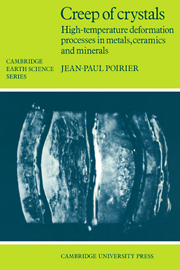Book contents
- Frontmatter
- Contents
- Preface
- 1 Mechanical background
- 2 The agents of deformation: lattice defects
- 3 Phenomenological and thermodynamical analysis of quasi-steady-state creep
- 4 Dislocation creep models
- 5 The effect of hydrostatic pressure on deformation
- 6 Creep polygonization and dynamic recrystallization
- 7 Diffusion creep, grain-boundary sliding and superplasticity
- 8 Transformation plasticity
- 9 Scaling and classification
- References
- Materials index
- Subject index
7 - Diffusion creep, grain-boundary sliding and superplasticity
Published online by Cambridge University Press: 06 October 2009
- Frontmatter
- Contents
- Preface
- 1 Mechanical background
- 2 The agents of deformation: lattice defects
- 3 Phenomenological and thermodynamical analysis of quasi-steady-state creep
- 4 Dislocation creep models
- 5 The effect of hydrostatic pressure on deformation
- 6 Creep polygonization and dynamic recrystallization
- 7 Diffusion creep, grain-boundary sliding and superplasticity
- 8 Transformation plasticity
- 9 Scaling and classification
- References
- Materials index
- Subject index
Summary
At high temperature and low stresses, deformation of fine-grained materials proceeds by mutually accommodating grain-boundary sliding and transport of matter. According to which mechanism provides the greater amount of strain, one speaks of diffusion creep or grain-boundary sliding but they are never really dissociated.
Diffusion creep was predicted theoretically before being observed. If the transport of matter occurs by lattice diffusion, it is Nabarro–Herring creep and the viscosity varies as the grain size squared; if the transport of matter occurs by grain-boundary diffusion, it is Coble creep and the viscosity varies as the grain size raised to the third power.
Grain-boundary sliding accommodated by diffusion creep is described by the same kind of equations as diffusion creep. In most materials, if the grain size is small and stable there is a domain of strain-rate where the strain-rate sensitivity is higher than for dislocation creep and where tensile deformation can take place in a stable manner up to very large strains: it is the superplastic domain. Models for superplastic flow account for the high strain-rate sensitivity and the possibility of large strains, by grain-boundary sliding during grain-shifting events, locally accommodated by diffusion creep or climb and glide of grain-boundary dislocations in the mantle of the grains.
Generalities
Intragranular creep by dislocation motion is not the only high-temperature deformation mode of crystals. We have already mentioned (§2.1) that strain can be achieved by transport of matter by diffusion (diffusion creep) or by shear along the grain boundaries (grain-boundary sliding or GBS).
- Type
- Chapter
- Information
- Creep of CrystalsHigh-Temperature Deformation Processes in Metals, Ceramics and Minerals, pp. 194 - 212Publisher: Cambridge University PressPrint publication year: 1985
- 3
- Cited by



